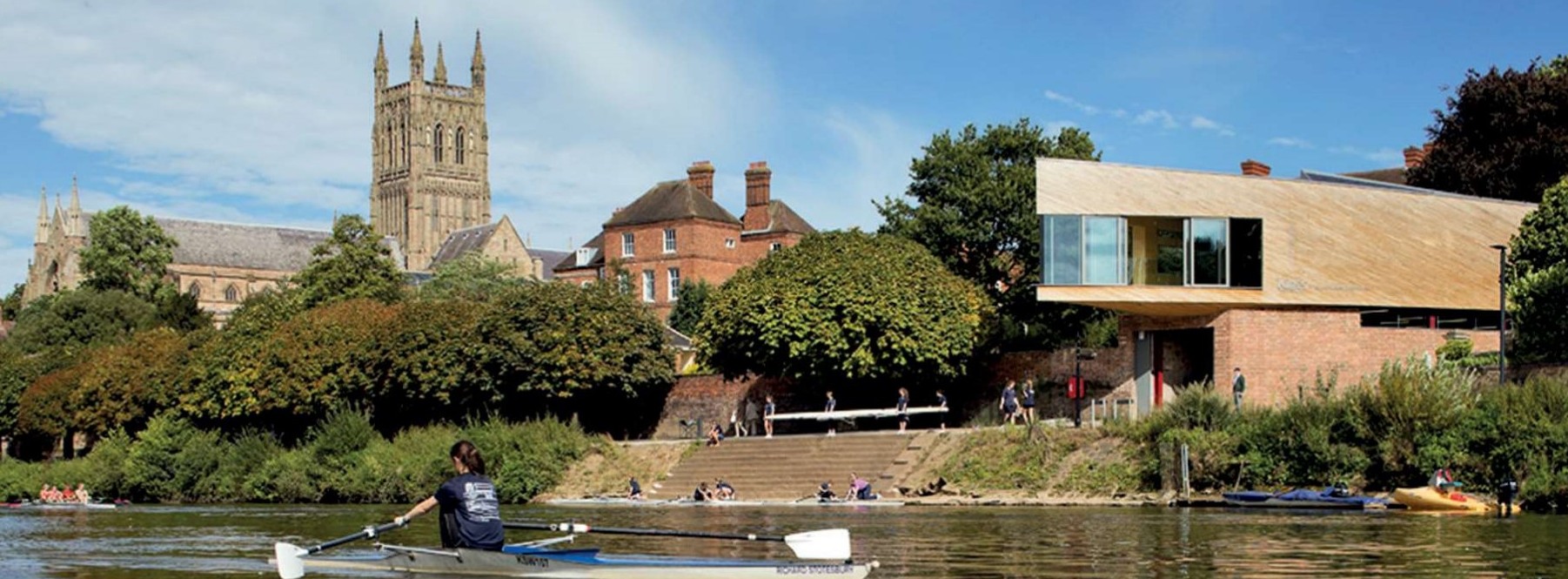The King’s School, Worcester
This article describes a tour by the Institute of Historic Building Conservation (IHBC) in 2016. The tour was led by John Christophers of Associated Architects, who was commissioned to prepare two 10-year master plans for King’s School, Worcester, from 1998-2018, and John Kirwan, a former lecturer in architecture and conservation, and a retired conservation officer.
[Image: Michael Baker Boathouse. Copyright Martine Hamilton Knight.]
The independent school, located in the heart of Worcester, straddling two conservation areas and a scheduled ancient monument, includes a mixture of buildings, several of which are listed. The master plan analysed how buildings were being used, concluding that some were surplus to requirements, and in need of upgrading or complete replacement.
The former Royal Worcester Porcelain Works canteen (1884) was refurbished for use as the art school and gallery. The roof space was opened up and supplemented with a three-storey extension to the rear. Delegates discussed the impact of the extension. John Kirwan, who was involved at planning application stage, suggested that it might have been less dominant had the extension been set further back.
The 1997 master plan identified the original Victorian Schoolhouse as the best location for a new library. The remodelled building provides a modern library arranged on two levels, illuminated by light wells with access by a ramped glass bridge. The building, with its low carbon emissions and architect-designed furniture (notably the bookcases), has won several architectural awards.
The tour featured two new buildings. The Keyes Building accommodates a multi-use sports hall, gym, classrooms, dance and drama studio, sixth-form area and subterranean car park. The aim was to minimise the bulk of the building and to respect the symmetry of the Victorian Royal Worcester building opposite (a two-storey red brick building with buff brick detailing) by providing an active frontage, with recessed windows and metal panelling, and adding oriel windows.
The building is faced with buff-coloured Ibstock brick in Saxon bond (a term coined by John Christophers to resemble ancient long-and-short work). The lettering sculptor Gary Breeze was commissioned to decorate the metal cladding. His distinctive lettering is used elsewhere in the school – yet another design feature tying the master plan together.
The Michael Baker Boathouse, a landmark building occupying a prominent location on the waterfront, with a distinctive cantilevered prow, is clad in sweet chestnut. The upper floor is light and airy with frameless glazing, and outstanding views to the river and cathedral beyond.
John Christophers explained that ‘the capital cost of a building is only a tiny fraction of the overall cost of running it’. By working closely together over a number of years, Christophers was able to persuade the school to take a longer view, incorporating design features which may initially appear to cost more but which will ultimately reduce running costs.
The tour was inspirational, rather like accompanying a 21st-century arts-and-crafts architect who designed not only the building but also the furniture and fittings. A talented architect can achieve outstanding results working closely with a sympathetic and well-informed client.
John Kirwan summed up the quality of his work perfectly in two words: meticulous and passionate.
Anne-Marie Lomax.
--Institute of Historic Building Conservation
[edit] Related articles on Designing Buildings Wiki
- Conservation.
- Dudley townscape heritage initiative.
- Free schools.
- FWB and Mary Charles Chartered Architects.
- IHBC articles.
- Institute of Historic Building Conservation.
- Malvern station, priory and other buildings.
- Tecton structures at Dudley Zoo.
- Worcester timber buildings and the Commandery.
- Worcester’s Georgian churches.
- Worcester sculptor William Forsyth.
IHBC NewsBlog
Images from inside a Grade II listed hotel show the scale of its collapse
The Corbett Arms in Tywyn has fallen into serious disrepair.
Old Sarum fire in listed (& disputed) WW1 Hangar - Wiltshire Council has sought legal advice after fire engulfed a listed First World War hangar that was embroiled in a lengthy planning dispute.
UK Antarctic Heritage Trust launches ‘Virtual Visit’ website area
The Trust calls on people to 'Immerse yourself in our heritage – Making Antarctica Accessible'
Southend Council pledge to force Kursaal owners to maintain building
The Council has pledged to use ‘every tool in the toolbox’ if urgent repairs are not carried out.
HE’s Research Magazine publishes a major study of the heritage of England’s suburbs
The article traces the long evolution of an internal programme to research 200 years of suburban growth
IHBC Context 183 Wellbeing and Heritage published
The issue explores issues at the intersection of heritage and wellbeing.
SAVE celebrates 50 years of campaigning 1975-2025
SAVE Britain’s Heritage has announced events across the country to celebrate bringing new life to remarkable buildings.
IHBC Annual School 2025 - Shrewsbury 12-14 June
Themed Heritage in Context – Value: Plan: Change, join in-person or online.
200th Anniversary Celebration of the Modern Railway Planned
The Stockton & Darlington Railway opened on September 27, 1825.
Competence Framework Launched for Sustainability in the Built Environment
The Construction Industry Council (CIC) and the Edge have jointly published the framework.















